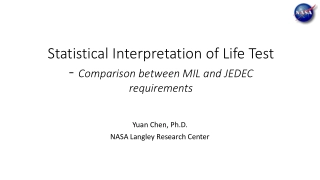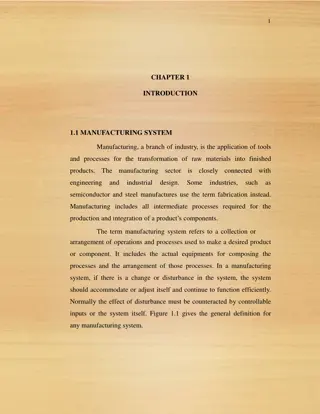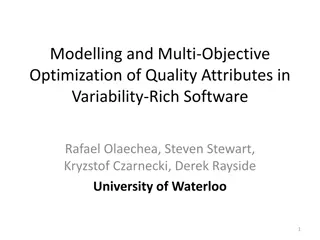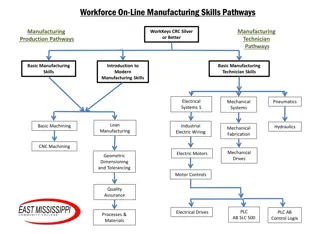Fabrication Variability in Semiconductor Manufacturing
Fabrication variability in semiconductor manufacturing refers to variations in physical characteristics of transistors, impacting their electrical parameters. This variability, whether systematic or random, can lead to performance deviations in digital circuits, affecting power consumption, timing, and overall functionality. The types of variability include spatial, temporal, and systematic, with device-to-device variability being a key concern at current process sizes. Strategies to analyze, model, and mitigate variability are essential for ensuring optimal circuit performance. Source: IEEE Journal of Solid-State Circuits.
Download Presentation

Please find below an Image/Link to download the presentation.
The content on the website is provided AS IS for your information and personal use only. It may not be sold, licensed, or shared on other websites without obtaining consent from the author.If you encounter any issues during the download, it is possible that the publisher has removed the file from their server.
You are allowed to download the files provided on this website for personal or commercial use, subject to the condition that they are used lawfully. All files are the property of their respective owners.
The content on the website is provided AS IS for your information and personal use only. It may not be sold, licensed, or shared on other websites without obtaining consent from the author.
E N D
Presentation Transcript
Overview What is fabrication variability? Sources of variability How to analyze & model variability Ways to mitigate variability 2
What is Fabrication Variability? Fabrication variability is variation in the physical characteristics of transistors, such as doping and patterning It may be systematic or random Systematic = same every time Random = different each time These variations cause electrical parameters of transistors (e.g., VT) to deviate from their designed values Random variability has become more prevalent with decreasing transistor sizes 3
Why is Fabrication Variability Significant? When a digital circuit is designed, implementations for its gates are selected (e.g., using standard cell libraries) The transistors used in the circuit are designed to have certain parameters (e.g. VT) The performance of the circuit (power, timing) is determined based on those parameters If the parameters vary from their expected value, then the circuit may not operate as intended or at all Some chips may function correctly but at a lower clock frequency or higher leakage power than intended Others may not function correctly at all and have to be discarded 4
Types of Variability Spatial Device-to-device / intra-die Die-to-die (within a wafer) Wafer-to-wafer Temporal Lot-to-lot (during production) Aging (during usage) Our focus will be on device-to-device variability, as it is the most significant limitation at the process sizes used today ( 90 nm) 5
Systematic Variability Systematic variability arises from limitations in fabrication equipment design and operation photolithography etching deposition and growth processes chemical-mechanical planarization (CMP) dosage of implants temperature of annealing steps In theory, systematic variability can be modeled exactly and compensated for in the design phase In practice, the variability is not known at design time or is too complex to model, so it is treated as random Source: Pang, Liang-Teck and Nikolic, Borivoje. Measurements and Analysis of Process Variability in 90 nm CMOS. IEEE JOURNAL OF SOLID-STATE CIRCUITS, VOL. 44, NO. 5, MAY 2009. 6
Random Variability Random variability is caused by atomistic effects (discreteness of atoms, quantum mechanical effects) Specific sources will be described next Random variability causes device-to-device variations and cannot be predicted ahead of time It can only be modeled statistically and requires adding a margin of error in the design phase Typically modeled as a normal (Gaussian) distribution 7
Systematic vs. Random Variability Systematic Random Source fabrication equipment atomistic Scale across chip, chip-to-chip, wafer-to-wafer device-to-device Local correlation yes no Can be corrected maybe no Can be modeled yes yes 8
Parameters That Vary Threshold voltage (VT) Saturation current (Ion) Device transconductance (Gm) Subthreshold (leakage) current (Ioff) Oxide tunneling current / gate current (Ig) 9
Sources of Variability Random discrete doping (RDD) Line-edge roughness & line-width roughness Interface roughness & oxide thickness variation Polysilicon granularity High-k dielectric morphology 10
Random Discrete Doping (RDD) Also known as random dopant fluctuation (RDF) As transistors become smaller, the number of dopant atoms decreases as well This effect is most pronounced in the transistor channel 100000 Average Number of 10000 Dopant Atoms 1000 100 10 1 10000 100 1 Technology Node (nm) Source: Kelin Kuhn et al. Managing Process Variation in Intel s 45nm CMOS Technology. Intel Technology Journal, Volume 12, Issue 2, 2008. At 1 um: 5,000 atoms At 45 nm: 100 atoms 11
Random Discrete Doping (RDD) RDD is a significant contributor to device-to-device VT variation ( VT) Responsible for ~65% of total VT at 65 nm and ~60% at 45 nm [Kuhn et al.] Formula: N N P Large number of atoms: continuous distribution Source: Peter A. Stolk et al. Modeling Statistical Dopant Fluctuations in MOS Transistors. IEEE TRANSACTIONS ON ELECTRON DEVICES, VOL. 45, NO. 9, SEPTEMBER 1998. Small number of atoms: discrete distribution 12
Effects of RDD As the number of dopant atoms decreases, the relative contribution of each dopant atom to VT increases => higher variation in VT In addition, the location of the dopant atoms in the channel becomes important The edges of the source & drain regions are uncertain, causing variation in the capacitance and resistance of the source and drain Source: Hon-Sum Philip Wong et al. Discrete random dopant distribution effects in nanometer-scale MOSFETs. Microelectronics Reliability 38 (1998). 13
Line-edge & Line-width roughness (LER & LWR) LER = lines of device features are not straight LWR = distance between lines is - not uniform LER & LWR arise from the lithography and etching processes They are most pronounced in poly- gate patterning Effects Increased Ioff Increased variation in VT LWR LER Source: Kuhn et al. 14
Line-edge & Line-width roughness (LER & LWR) The limits of the lithography process are determined by the Rayleigh scaling equation Wmin = minimum linewidth k1 = dimensionless scaling parameter = exposure wavelength NA = numerical aperture of the projection optics For current technology (F2laser, = 157.6 nm), Wmin = 53 nm Source: Brunner , Timothy A. Why optical lithography will live forever. Journal of Vacuum Science & Technology B: Microelectronics and Nanometer Structures, Vol. 21, Issue 6, Nov. 2003 15
Line-edge & Line-width roughness (LER & LWR) As feature size approaches the minimum linewidth, statistical variation in incident photon count becomes significant Other sources of variation are photoresist absorption rate, chemical reactivity, and molecular composition Source: K. Bernstein et al. High-performance CMOS variability in the 65-nm regime and beyond. IBM J. RES. & DEV. VOL. 50 NO. 4/5 JULY/SEPTEMBER 2006. 16
Interface roughness & oxide thickness variation The interface roughness due to oxide thickness variation leads to significant fluctuation in Vth[6] Introduced by Si/SiO2 interface roughness and polysilicon gate/SiO2 (remote) interface roughness through TOX (gate-oxide thickness) variation interface roughness can introduce more than 50% variation in the value of TOX for devices with a TOX of about 1 nm. 17
Interface roughness & oxide thickness variation 18
Interface roughness & oxide thickness variation The unique random pattern of each MOSFET s gate oxide and the related surface landscape and potential fluctuations will contribute substantially to the intrinsic parameter variation between such devices. The intrinsic parametric variability due to Si/SiO2 and polysilicon-gate/SiO2 interface roughness is also statistically independent The random Si/SiO2 and gate/SiO2 inter-faces are generated from a power spectrum corresponding to the autocorrelation function of the interface roughness 19
Interface roughness & oxide thickness variation Sources Asenov, A.; Kaya, S.; Davies, J.H.; , "Intrinsic threshold voltage fluctuations in decanano MOSFETs due to local oxide thickness variations," Electron Devices, IEEE Transactions on , vol.49, no.1, pp.112-119, Jan 2002 Asenov, A.; Cathignol, A.; Cheng, B.; McKenna, K.P.; Brown, A.R.; Shluger, A.L.; Chanemougame, D.; Rochereau, K.; Ghibaudo, G.; , "Origin of the Asymmetry in the Magnitude of the Statistical Variability of n- and p-Channel Poly-Si Gate Bulk MOSFETs," Electron Device Letters, IEEE , vol.29, no.8, pp.913-915, Aug. 2008 20
Polysilicon Granularity Poly-silicon granularity (PSG) increases the uncertainty in gate doping and process variability Caused by Fermi-level pinning Gate dopant diffusion is enhanced along the grain boundaries(GBs) Leading to non-uniform poly-silicon gate doping Potential localized penetration of the dopants through the gate oxide in to the channel region. 21
Polysilicon Granularity Polysilicon (polycrystalline silicon) is a form of silicon in which Si atoms do not form a single crystal but rather multiple crystals called grains. The Fermi level of an atom is its highest electron energy level at absolute zero temperature Normally, charge is redistributed at the interface between materials, and the Fermi level changes. Due to the high density of defect states in poly-Si, the Fermi level is pinned, and electron diffusion is enhanced at the interface between grains Source: Brown, A.R.; Roy, G.; Asenov, A. "Impact of Fermi level pinning at polysilicon gate grain boundaries on nano-MOSFET variability: A 3-D simulation study," Solid-State Device Research Conference, 2006. ESSDERC 2006. Proceeding of the 36th European, pp.451-454, 19-21 Sept. 2006 Source: http://hyperphysics.phy-astr.gsu.edu/hbase/solids/fermi.html#c1 22
Polysilicon Granularity Effect of polysilicon granularity Parametric fluctuations VT variability due to PSG is stronger than RDD in MOSFETs with L = 30 nm Fermi-level pinning was responsible for dramatically increasing the threshold voltage in PMOS transistors using a hafnium silicate (HfSiOx) film as a high-k gate dielectric, which decreased the driving ability of the transistor Source: How a change in thinking led to the development of our low standby power CMOS technology and the story behind the birth of "ultra-thin high-k theory," http://www2.renesas.com/magazine/en/vol_0070/vol_0070_1.html 23
High-k dielectric morphology To reduce the excess of gate leakage currents in MOS devices, the ultra thin SiO2 gate oxide is replaced by other high-k dielectric materials Provides a thicker physical TOX to reduce the direct- tunneling gate leakage current while ensuring an ultra-thin electrical TOX High-k gate dielectric and a metal gate process introduces significant process variability because of interface roughness between Si and the high-k dielectric. Mobility degradation and TOX variation 24
Analyzing and Modeling Process Variability The fabrication variability in the parameters in device cause severe variability in the performance of advanced VLSI circuits and systems. The accurate modeling for the process variability Possible to predict the performance of VLSI circuits Robust design High yield rate 25
Models of Process Variability Statistical models Worst-case corner Statistical corner TCAD-based statistical corner Monte Carlo Analysis methods Statistical timing analysis Statistical leakage analysis 26
Worst-case Corner Model Worst-case corner model gives designer the pessimistic process variability model by selecting the wide range of upper limit and lower limit Main Idea Vth = Vtho + n*std(Vth) Offsetting the selected process-sensitive compact model parameters by fixed number n to account for the window of process variability Vtho is a selected model parameter of the typical model typical model is generated from the measured data on a single golden wafer of the center-line process n is selected to set the fixed lower and upper limits(typically 3 or 6) 27
Worst-case Corner Model Worst-case four corner model o Conventionally, process variability is modeled on the basis of the worst-case four corners corners for analog applications For modeling worst-case speed slow NMOS and slow PMOS(SS) corner For modeling worst-case power fast NMOS and fast PMOS(FF) corner corners for digital applications For modeling worst-case 1 fast NMOS and slow PMOS(FS) corner For modeling worst-case 0 slow NMOS and fast PMOS(SF) corner o o o o 28
Worst-case Corner Model Advantages Worst case corner models give designers the capability to simulate the pass/fail results of a typical design and are usually pessimistic. Disadvantages The fixed-corner method is too wide Some valid designs can not be accepted in worst-case corner model The correlations between the device parameters are ignored 29
Worst-case Corner Model vs Statistical Corner Model Data Range of NMOS Isat vs PMOS Isat with Worst-case Corner Model Data Range of NMOS Vth vs PMOS Vth with Worst-case Corner Model Source : Samar K. Saha, Modeling Process Variability in Scaled CMOS Technology , Design & Test of Computers, IEEE , vol.27, no.2, pp.8-16, March-April 2010 Data Range of NMOS Vth vs PMOS Vth with Statistical Corner Model Data Range of NMOS Isat vs PMOS Isat with Statistical Corner Model 30
Statistical Corner Model For more realistic modeling for process variability than worst-case corner model. Using data from different dies, wafers, and wafer lots collected over a long enough period of time to represents realistic process variability of the target technology The difference between statistical corner model and worst- case corner-model Statistical corner model use the realistic std of the corresponding model parameter of its typical model Std is obtained from the distribution of a large set of production data Statistical models can pass a valid design, which were rejected in worst-corner model 31
TCAD-based Statistical Model When developing a new VLSI technology, there is no historical production data to use as a basis for statistical modeling The technology CAD (TCAD) modeling approach uses simulations to generate an initial statistical model The simulations are chosen based on the lower and upper limits of the most sensitive process-control variables (e.g., gate-oxidation temperature, p- and n- halo implant dose and energy, TOX, and L) The model is refined as data is collected from production runs Source: Saha, S.K.; "Modeling Process Variability in Scaled CMOS Technology," Design & Test of Computers, IEEE, vol.27, no.2, pp.8-16, March-April 2010 32
Monte Carlo Model A Monte Carlo simulation of a circuit is a series of simulation runs where the device parameters for each run are randomly generated based on the distribution of those parameters in the model In contrast, corner models use only lower and upper limits Advantages Accurate Allows for directly estimating the yield of a VLSI design Disadvantages Requires running many simulations Assumes that device parameters are independent Source: Orshansky, M. et al. "A statistical performance simulation methodology for VLSI circuits," Design Automation Conference, 1998. Proceedings , pp. 402- 407, 15-19 Jun 1998 33
Statistical Timing Analysis As process technologies have scaled, intra-die variations have grown to play a significant role in determining delay and power distributions Random variables that captures intra-die variations can be independent or correlated across gates Monte Carlo based techniques even more expensive Corner based models cannot guarantee to cover the worst case enough. Modeling the impact of fabrication randomness on the chip's timing characteristics. Predict the probability density function(PDF) of delay Predict the statistical spread in chip's timing randomness accurately. 34
Statistical Timing Analysis Statistical Timing Analysis vs Deterministic Timing Analysis P(A0) Deterministic Timing Analysis Ai i Ao Arrival time Ao = max(Ai + Dio , Aj + Djo) 0 Aj j P(A0) Dio: Delay from Input Node i to Output node o Djo: Delay from Input Node j to Output node o Statistical Timing Analysis A0 Arrival time Ao => CDF distributed 35
Statistical Timing Analysis Block-based timing analysis Based on a topological traversal of the timing graph Generates the arrival times and required times for each node Working forward (and backward) from the clocked elements Advantage No path selection -> complete analysis Disadvantage Need to consider correlations for getting statistical max and min Path-based timing analysis Extracting a set of paths from the circuit Sums gate and wire delays on specific paths Advantage The statistical analysis is simple Disadvantage Cannot cover the case that the unselected paths are relevant Path Selection is important 36
Statistical Leakage Power Analysis Leakage Power becomes a major components of the total power Leakage power contributes approximately 50% of the total power dissipation in the 90nm technology(Intel) Process variation has a significant impact on leakage The Ioff is closely related to Vth and Tox Major components in leakage current Sub-threshold leakage(Isub) - closely related to Vth Gate leakage(Igate) - closely related to Tox 37
Statistical Leakage Power Analysis High-level Statistical Analysis Useful in early design stage when detailed information about the design is not available Information : total device width or relative fraction of on/off devices in a design( without detailed gate level information) The analysis process Assume that the process parameters(Vth) are normally distributed J. Kao, S. Narendra, and A. Chandrakasan. Subthreshold leakage modeling and reduction techniques. In ICC AD '02: Proceedings of the 2002 IEEE/ACM international conference on Computer-aided design, pages 141-148, New York, NY, USA, 2002. ACM Press. 38
Statistical Leakage Power Analysis Gate-level Statistical Analysis o Estimation of leakage currents for individual gates and then summation of these estimates to calculate the overall leakage of a design 39
Mitigating Process Variability Design-time optimization Statistical gate sizing Statistical buffer insertion Post-silicon tunability Post-silicon tunable clock tree Ring oscillators Adaptive body bias & adaptive supply voltage 40
Statistical Gate Sizing Problem in static gate sizing Based on the static delay model The static delay model cannot cover the actual delay later in a chip. Gate will have same delay all the time Uncertainty in wire delays Not all details of the final layout might be known yet Statistical Gate Sizing Using statistical distribution of wire delay model and gate delay model Deciding the gate size under the desirable delay 41
Statistical Buffer Insertion Buffer Insertion Widely used interconnection optimization method in intra-level cell Statistical Delay Model Dk = Dko(Pio) + Dk(Xk, Yk, Pi) Pi : parameter variation k : Position Dko : Nominal value of Delay 42
Post-silicon tunable clock tree Fabrication variability causes skew in a nominally balanced clock distribution network (tree) To counter this, post-silicon tunable clock buffers can be inserted into the tree A tunable buffer consists of two inverters with a bank of capacitors in between Each capacitor has a pass gate that allows it to be connected to or disconnected from the output of the first inverter The delay of the buffer is set dynamically based on a clock phase detector to cancel clock skew The goal is to obtain the best timing yield while inserting as few tunable clock buffers as possible Similar to the normal buffer insertion problem, but the cost of the buffer is proportional to its tunable range Source: Jeng-Liang Tsai et al. "Statistical timing analysis driven post-silicon-tunable clock-tree synthesis," Computer-Aided Design, 2005. ICCAD-2005. IEEE/ACM International Conference on, pp. 575- 581, 6-10 Nov. 2005 43
Adaptive Body Bias (ABB) ABB uses the transistor body effect to change VT during circuit operation Normally, the body (substrate) of a MOSFET is tied to its source Using ABB, the substrate is forward or reverse biased within a range chosen to prevent crossing the forward threshold of the transistor junctions (CN03 used 20% of nominal VDD) ABB can be applied to all transistors or just to n-type or p- type transistors Drawback: additional on-chip power networks are needed for the body voltage Source: Chen, Tom and Naffziger, Samuel. Comparison of Adaptive Body Bias (ABB) and Adaptive Supply Voltage (ASV) for Improving Delay and Leakage Under the Presence of Process Variation. IEEE TRANSACTIONS ON VLSI SYSTEMS, VOL. 11, NO. 5, OCTOBER 2003. 44
Adaptive Supply Voltage (ASV) ASV varies the supply voltage in order to trade speed for power consumption (CN03 used 20% of nominal VDD) Benefits No additional power distribution network needed Drawbacks Potential reliability issues when exceeding the nominal supply voltage (due hot electron and electromigration) Memory may be less reliable when operated below its nominal supply voltage Source: Chen, Tom and Naffziger, Samuel. Comparison of Adaptive Body Bias (ABB) and Adaptive Supply Voltage (ASV) for Improving Delay and Leakage Under the Presence of Process Variation. IEEE TRANSACTIONS ON VLSI SYSTEMS, VOL. 11, NO. 5, OCTOBER 2003. 45
Adaptive Body Bias (ABB) & Adaptive Supply Voltage (ASV) Both approaches allow trading power for performance and vice versa Both approaches are coarse-grained and thus are more suited to reducing variation between chips than they are to reducing within-chip variation The approach could be applied at a finer granularity, but power distribution would be more complex Yields improved by up to a factor of 6, with a more pronounced difference for lower original yields ASV provides a slightly better improvement in yield than ABB, but only by 2% Source: Chen, Tom and Naffziger, Samuel. Comparison of Adaptive Body Bias (ABB) and Adaptive Supply Voltage (ASV) for Improving Delay and Leakage Under the Presence of Process Variation. IEEE TRANSACTIONS ON VLSI SYSTEMS, VOL. 11, NO. 5, OCTOBER 2003. 46
Ring Oscillators A ring oscillator is a series of an odd number of inverters connected in a loop The output of each inverter oscillates with a frequency that depends on the number of inverters and the electrical parameters of the inverters If enough inverters are used, the frequency depends only on the average values of the parameters Thus, the ring oscillator can be used as a reference circuit against which other circuits can be compared to measure the effects of various sources of variation Source: Bhushan, Manjul et al. Ring Oscillators for CMOS Process Tuning and Variability Control. IEEE TRANSACTIONS ON SEMICONDUCTOR MANUFACTURING, VOL. 19, NO. 1, FEBRUARY 2006. 47
Conclusion Fabrication variability comes from many different sources and cannot be eliminated entirely It negatively affects circuit performance and power dissipation Good modeling of fabrication variability allows for estimating the effect of variability while designing a circuit Circuits can and should be designed to be robust in the face of variability 48












